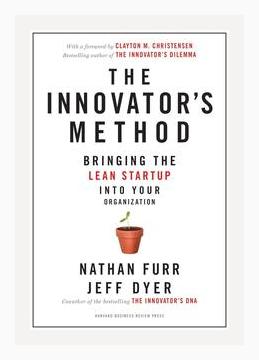Innovation and CreativityEntrepreneurship and StartupsDesign ThinkingR&D ManagementMarket Validation
Title: The Innovator’s Method: Bringing the Lean Start-up into Your Organization
Authors: Nathan Furr, Jeff Dyer
Published: 2014
Categories: Market Validation, Design Thinking, R&D Management
Introduction
“The Innovator’s Method: Bringing the Lean Startup into Your Organization” is an authoritative guide aimed at helping businesses innovate successfully by integrating the lean startup approach. Nathan Furr and Jeff Dyer translate Silicon Valley’s best practices into actionable methods for large organizations. This guide is much-needed in today’s rapidly changing market where traditional methods often falter when faced with uncertainty.
I. Ideation
1. Observing and Understanding Customers
– Point: To generate breakthrough ideas, businesses should start by deeply understanding customers’ problems.
– Example: The authors highlight Intuit’s “Follow Me Home” program where employees observe how customers use their products at home.
– Action: Initiate customer shadowing sessions where employees spend a day with customers to observe their usage patterns and pain points firsthand.
2. Targeting a Problem Worth Solving
– Point: Identifying and targeting significant, unsolved problems is crucial to successful innovation.
– Example: Dropbox initially targeted the problem of complex file sharing and syncing, providing a simple, reliable solution.
– Action: Conduct problem interviews with at least 20 potential customers to deeply understand and prioritize their pain points.
II. Problem Framing and Solution Development
1. Framing the Problem
– Point: Clearly define and frame the problem to ensure that all members of the team are aligned.
– Example: Procter & Gamble utilizes “problem statements” which succinctly outline problems in customer-centric language.
– Action: Create a clear problem statement document for each project to guide all subsequent innovation activities.
2. Prototyping Solutions
– Point: Develop quick and inexpensive prototypes to test hypotheses about how to solve the problem.
– Example: IDEO rapidly develops simple prototypes to gather early feedback, minimizing cost and time to development.
– Action: Use materials like cardboard or digital mockups to build prototypes in under a week for quick testing and iteration.
III. Testing and Validating Assumptions
1. Hypothesis-driven Experimentation
– Point: Build and test hypotheses rigorously to validate assumptions and iterate based on feedback.
– Example: Amazon’s famous data-driven approach tests everything from new features to webpage designs by running A/B experiments.
– Action: Define specific, testable hypotheses for each assumption embedded in your innovation and use split testing to validate these with real customer data.
2. Minimum Viable Product (MVP)
– Point: Implement the lean startup concept of MVP to learn effectively from customers with minimal resources.
– Example: Zappos’ founder Nick Swinmurn validated the assumption that customers would buy shoes online by showcasing photos of shoes without any inventory, then purchasing from retailers after orders were made.
– Action: Develop MVPs that are functional enough to provide key insights but stripped down to save resources, e.g., landing pages, pre-order systems.
IV. Scaling and Optimizing
1. Building Sustainable Business Models
– Point: Ensure long-term sustainability by continuously iterating on and improving the business model.
– Example: Airbnb evolved its business model multiple times based on invaluable customer feedback and market data, adjusting pricing, host onboarding, and user trust mechanisms.
– Action: Use the Business Model Canvas to document your current model, regularly reviewing and revising based on data and pivoting as necessary.
2. Scaling Operations and Ensuring Quality
– Point: As validated ideas grow, it’s crucial to scale operations while maintaining product quality.
– Example: Google’s “20% time” policy allowed employees to spend a fifth of their time on new ideas, leading to scalable innovations like Gmail.
– Action: Implement flexible working hours or encourage “innovation time” for employees to explore and develop new ideas without immediate constraints.
V. Organizational Readiness and Culture
1. Creating an Innovative Culture
– Point: Embedding innovation within the organizational culture is essential for sustained success.
– Example: 3M’s commitment to an innovative culture led to the creation of the famous Post-it Notes, originated from an employee’s side project.
– Action: Foster a culture of experimentation and learning by rewarding risk-taking and celebrating failures as learning opportunities.
2. Training and Development Programs
– Point: Educate and empower employees with the tools and knowledge needed to drive innovation.
– Example: Ericsson’s “Idea Quest” program that trains engineers and solicits innovative ideas from across the company.
– Action: Develop internal training programs focused on lean startup methodologies, design thinking, and agile frameworks.
VI. Integrating Insights and Continuous Learning
1. Feedback Loops
– Point: Establish tight, iterative feedback loops with customers to continuously refine offerings.
– Example: Spotify’s use of data-driven product teams that constantly monitor user behavior and adjust their service accordingly.
– Action: Set up channels for continuous user feedback, such as user communities or regular customer surveys, and establish dedicated teams to analyze and act on the insights.
2. Metrics and Performance Evaluation
– Point: Use appropriate metrics to evaluate the performance of innovations continuously.
– Example: LinkedIn tracks “North Star” metrics like weekly active users to gauge the overall health and growth of their platform.
– Action: Identify key performance indicators (KPIs) relevant to each project and set regular check-in points to measure progress and adjust strategies as needed.
Conclusion
“The Innovator’s Method” by Nathan Furr and Jeff Dyer is an indispensable guide for translating lean startup principles into effective corporate innovation strategies. It provides a pragmatic, step-by-step approach to fostering innovation by deeply understanding customer needs, rapidly prototyping, testing, and iterating on ideas, and creating a culture that celebrates continuous learning and improvement. By applying these principles, organizations can navigate uncertainty, drive growth, and remain competitive in an ever-evolving market landscape.
Innovation and CreativityEntrepreneurship and StartupsDesign ThinkingR&D ManagementMarket Validation
